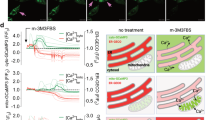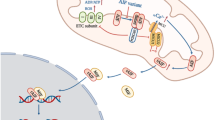Abstract
Apoptosis-inducing factor (AIF), a flavoprotein with NADH oxidase activity anchored to the mitochondrial inner membrane, is known to be involved in complex I maintenance. During apoptosis, AIF can be released from mitochondria and translocate to the nucleus, where it participates in chromatin condensation and large-scale DNA fragmentation. The mechanism of AIF release is not fully understood. Here, we show that a prolonged (∼10 min) increase in intracellular Ca2+ level is a prerequisite step for AIF processing and release during cell death. In contrast, a transient ATP-induced Ca2+ increase, followed by rapid normalization of the Ca2+ level, was not sufficient to trigger the proteolysis of AIF. Hence, import of extracellular Ca2+ into staurosporine-treated cells caused the activation of a calpain, located in the intermembrane space of mitochondria. The activated calpain, in turn, cleaved membrane-bound AIF, and the soluble fragment was released from the mitochondria upon outer membrane permeabilization through Bax/Bak-mediated pores or by the induction of Ca2+-dependent mitochondrial permeability transition. Inhibition of calpain, or chelation of Ca2+, but not the suppression of caspase activity, prevented processing and release of AIF. Combined, these results provide novel insights into the mechanism of AIF release during cell death.
Similar content being viewed by others
Log in or create a free account to read this content
Gain free access to this article, as well as selected content from this journal and more on nature.com
or
Abbreviations
- AIF:
-
apoptosis-inducing factor
- Atg5:
-
autophagy-related gene 5
- IMS:
-
intermembrane space
- IP3:
-
inositol 1,4,5-trisphosphate
- MEF:
-
mouse embryonic fibroblast
- MPT:
-
mitochondrial permeability transition
- NSCLC:
-
non-small-cell lung carcinoma
- OMM:
-
outer mitochondrial membrane
- PKC 412:
-
protein kinase C inhibitor
- STS:
-
staurosporine
- tBid:
-
truncated Bid
References
Thompson CB . Apoptosis in the pathogenesis and treatment of disease. Science 1995; 267: 1456–1462.
Arends MJ, Wyllie AH . Apoptosis: mechanisms and roles in pathology. Int Rev Exp Pathol 1991; 32: 223–254.
Cande C, Vahsen N, Kouranti I, Schmitt E, Daugas E, Spahr C et al. AIF and cyclophilin A cooperate in apoptosis-associated chromatinolysis. Oncogene 2004; 23: 1514–1521.
Du C, Fang M, Li Y, Li L, Wang X . Smac, a mitochondrial protein that promotes cytochrome c-dependent caspase activation by eliminating IAP inhibition. Cell 2000; 102: 33–42.
Liu X, Kim CN, Yang J, Jemmerson R, Wang X . Induction of apoptotic program in cell-free extracts: requirement for dATP and cytochrome c. Cell 1996; 86: 147–157.
Hegde R, Srinivasula SM, Zhang Z, Wassell R, Mukattash R, Cilenti L et al. Identification of Omi/HtrA2 as a mitochondrial apoptotic serine protease that disrupts inhibitor of apoptosis protein–caspase interaction. J Biol Chem 2002; 277: 432–438.
Susin SA, Lorenzo HK, Zamzami N, Marzo I, Snow BE, Brothers GM et al. Molecular characterization of mitochondrial apoptosis-inducing factor. Nature 1999; 397: 441–446.
Verhagen AM, Ekert PG, Pakusch M, Silke J, Connolly LM, Reid GE et al. Identification of DIABLO, a mammalian protein that promotes apoptosis by binding to and antagonizing IAP proteins. Cell 2000; 102: 43–53.
Suzuki Y, Imai Y, Nakayama H, Takahashi K, Takio K, Takahashi R . A serine protease, HtrA2, is released from the mitochondria and interacts with XIAP, inducing cell death. Mol Cell 2001; 8: 613–621.
Ravagnan L, Gurbuxani S, Susin SA, Maisse C, Daugas E, Zamzami N et al. Heat-shock protein 70 antagonizes apoptosis-inducing factor. Nat Cell Biol 2001; 3: 839–843.
Joseph B, Ekedahl J, Lewensohn R, Marchetti P, Formstecher P, Zhivotovsky B . Defective caspase-3 relocalization in non-small cell lung carcinoma. Oncogene 2001; 20: 2877–2888.
Gallego MA, Joseph B, Hemstrom TH, Tamiji S, Mortier L, Kroemer G et al. Apoptosis-inducing factor determines the chemoresistance of non-small-cell lung carcinomas. Oncogene 2004; 23: 6282–6291.
Hemstrom TH, Joseph B, Schulte G, Lewensohn R, Zhivotovsky B . PKC 412 sensitizes U1810 non-small cell lung cancer cells to DNA damage. Exp Cell Res 2005; 305: 200–213.
Miramar MD, Costantini P, Ravagnan L, Saraiva LM, Haouzi D, Brothers G et al. NADH oxidase activity of mitochondrial apoptosis-inducing factor. J Biol Chem 2001; 276: 16391–16398.
Klein JA, Longo-Guess CM, Rossmann MP, Seburn KL, Hurd RE, Frankel WN et al. The harlequin mouse mutation downregulates apoptosis-inducing factor. Nature 2002; 419: 367–374.
Vahsen N, Cande C, Briere JJ, Benit P, Joza N, Larochette N et al. AIF deficiency compromises oxidative phosphorylation. EMBO J 2004; 23: 4679–4689.
Loeffler M, Daugas E, Susin SA, Zamzami N, Metivier D, Nieminen AL et al. Dominant cell death induction by extramitochondrially targeted apoptosis-inducing factor. FASEB J 2001; 15: 758–767.
Otera H, Ohsakaya S, Nagaura Z, Ishihara N, Mihara K . Export of mitochondrial AIF in response to proapoptotic stimuli depends on processing at the intermembrane space. EMBO J 2005; 24: 1375–1386.
Joza N, Susin SA, Daugas E, Stanford WL, Cho SK, Li CY et al. Essential role of the mitochondrial apoptosis-inducing factor in programmed cell death. Nature 2001; 410: 549–554.
Polster BM, Basanez G, Etxebarria A, Hardwick JM, Nicholls DG . Calpain I induces cleavage and release of apoptosis-inducing factor from isolated mitochondria. J Biol Chem 2005; 280: 6447–6454.
Yuste VJ, Moubarak RS, Delettre C, Bras M, Sancho P, Robert N et al. Cysteine protease inhibition prevents mitochondrial apoptosis-inducing factor (AIF) release. Cell Death Differ 2005; 12: 1445–1448.
Cao G, Xing J, Xiao X, Liou AK, Gao Y, Yin XM et al. Critical role of calpain I in mitochondrial release of apoptosis-inducing factor in ischemic neuronal injury. J Neurosci 2007; 27: 9278–9293.
Badugu R, Garcia M, Bondada V, Joshi A, Geddes JW . N terminus of calpain 1 is a mitochondrial targeting sequence. J Biol Chem 2008; 283: 3409–3417.
McConkey DJ, Orrenius S . The role of calcium in the regulation of apoptosis. J Leukoc Biol 1996; 59: 775–783.
Nicotera P, Zhivotovsky B, Orrenius S . Nuclear calcium transport and the role of calcium in apoptosis. Cell Calcium 1994; 16: 279–288.
Orrenius S, Zhivotovsky B, Nicotera P . Regulation of cell death: the calcium-apoptosis link. Nat Rev Mol Cell Biol 2003; 4: 552–565.
Yousefi S, Perozzo R, Schmid I, Ziemiecki A, Schaffner T, Scapozza L et al. Calpain-mediated cleavage of Atg5 switches autophagy to apoptosis. Nat Cell Biol 2006; 8: 1124–1132.
Hood JL, Logan BB, Sinai AP, Brooks WH, Roszman TL . Association of the calpain/calpastatin network with subcellular organelles. Biochem Biophys Res Commun 2003; 310: 1200–1212.
Hood JL, Brooks WH, Roszman TL . Differential compartmentalization of the calpain/calpastatin network with the endoplasmic reticulum and Golgi apparatus. J Biol Chem 2004; 279: 43126–43135.
Molinari M, Carafoli E . Calpain: a cytosolic proteinase active at the membranes. J Membr Biol 1997; 156: 1–8.
Goll DE, Thompson VF, Li H, Wei W, Cong J . The calpain system. Physiol Rev 2003; 83: 731–801.
Arrington DD, Van Vleet TR, Schnellmann RG . Calpain 10: a mitochondrial calpain and its role in calcium-induced mitochondrial dysfunction. Am J Physiol Cell Physiol 2006; 291: C1159–C1171.
Churbanova IY, Sevrioukova IF . Redox-dependent changes in molecular properties of mitochondrial apoptosis-inducing factor. J Biol Chem 2008; 283: 5622–5631.
Kruman I, Guo Q, Mattson MP . Calcium and reactive oxygen species mediate staurosporine-induced mitochondrial dysfunction and apoptosis in PC12 cells. J Neurosci Res 1998; 51: 293–308.
Murphy RC, Schneider E, Kinnally KW . Overexpression of Bcl-2 suppresses the calcium activation of a mitochondrial megachannel. FEBS Lett 2001; 497: 73–76.
Acknowledgements
This work was supported by grants from the Swedish Research Council, the Swedish and the Stockholm Cancer Societies, the Swedish Childhood Cancer Foundation, the EC FP-6 (Oncodeath and Chemores) as well as the FP7 (Apo-Sys) programs. MO is a post-doctoral fellow of the Wenner-Gren Foundation, Stockholm, Sweden. MH is the recipient of a stipend for academic exchange from the DAAD, Germany. We thank Bruno Antonsson for the generous gift of plasmid pET23tBid and the late Stan Korsmeyer for Bax/Bak DKO MEFs.
Author information
Authors and Affiliations
Corresponding author
Additional information
Edited by G Melino
Rights and permissions
About this article
Cite this article
Norberg, E., Gogvadze, V., Ott, M. et al. An increase in intracellular Ca2+ is required for the activation of mitochondrial calpain to release AIF during cell death. Cell Death Differ 15, 1857–1864 (2008). https://doi.org/10.1038/cdd.2008.123
Received:
Revised:
Accepted:
Published:
Issue date:
DOI: https://doi.org/10.1038/cdd.2008.123
Keywords
This article is cited by
-
Recent advances and applications of peptide–agent conjugates for targeting tumor cells
Journal of Cancer Research and Clinical Oncology (2023)
-
Upregulation of Ca2+-binding proteins contributes to VTA dopamine neuron survival in the early phases of Alzheimer’s disease in Tg2576 mice
Molecular Neurodegeneration (2022)
-
The role of cGMP-signalling and calcium-signalling in photoreceptor cell death: perspectives for therapy development
Pflügers Archiv - European Journal of Physiology (2021)
-
Modelling human CNS injury with human neural stem cells in 2- and 3-Dimensional cultures
Scientific Reports (2020)
-
Neuroprotective Effects of Dexmedetomidine Preconditioning on Oxygen-glucose Deprivation-reoxygenation Injury in PC12 Cells via Regulation of Ca2+-STIM1/Orai1 Signaling
Current Medical Science (2020)



